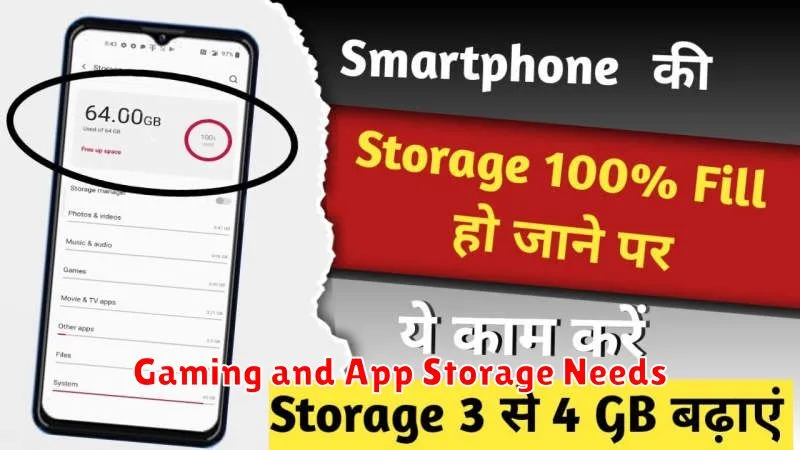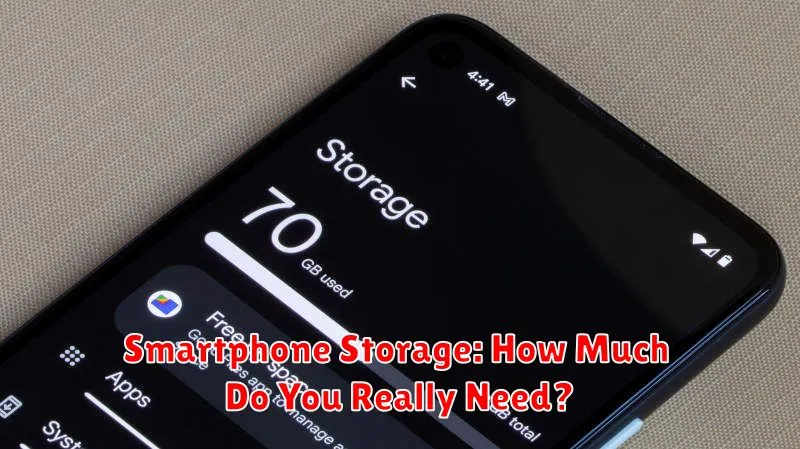In today’s digital age, our smartphones have become indispensable tools, serving as cameras, entertainment centers, and even mobile offices. With the ever-increasing size of apps, photos, and videos, the question of adequate smartphone storage becomes crucial. How much storage do you really need on your smartphone? Choosing the right storage capacity can significantly impact your device’s performance and your overall user experience. This article will delve into the factors to consider when determining your smartphone storage needs, helping you avoid the frustration of a full phone and ensuring you select a device with the appropriate capacity for your usage patterns.
Understanding your personal smartphone usage is paramount when deciding on the storage capacity of your next device. From casual users primarily focused on communication to avid photographers and mobile gamers, the storage requirements vary significantly. This guide will help you assess your individual needs, taking into account your reliance on cloud storage, app usage, media consumption habits, and future smartphone usage projections. By considering these factors, you can determine how much smartphone storage you really need and make an informed purchase decision, avoiding potential storage limitations down the line.
Understanding Storage Capacity (GB)
Storage capacity, measured in gigabytes (GB), determines how much data your smartphone can hold. Think of it like the size of your house – a larger house can hold more furniture. Similarly, a larger storage capacity allows you to store more files, apps, photos, and videos.
One gigabyte (GB) is roughly equivalent to 1,000 megabytes (MB). Higher GB numbers indicate greater storage capacity. A 64GB phone can hold considerably more data than a 32GB phone. Choosing the right storage size depends on your individual usage patterns.
System Files vs User Data
Understanding the difference between system files and user data is crucial for managing your smartphone’s storage. System files are essential components required for the operating system to function. These include the OS itself, pre-installed apps, and other core software. You generally cannot modify or delete these files directly.
User data, on the other hand, comprises everything you create, download, or store on your device. This includes photos, videos, music, documents, app data, and downloaded applications. This is the data you have direct control over and can manage, delete, or back up as needed.
Impact of Photos and Videos
Photos and videos are major consumers of smartphone storage. High-resolution images and 4K video can quickly fill up even large storage capacities. The impact is compounded by the increasing prevalence of multiple-lens camera systems, enabling features like portrait mode and wide-angle shots, which further increase file sizes.
Consider the following approximate file sizes:
- Standard photo: 2-5MB
- High-resolution photo: 5-10MB
- 1 minute of 1080p video: 100-200MB
- 1 minute of 4K video: 350-700MB
These numbers demonstrate how quickly media can consume storage, making it a crucial factor when deciding on smartphone storage capacity.
Gaming and App Storage Needs

Mobile gaming has become increasingly demanding in terms of storage. Modern games often require several gigabytes of space, with updates adding even more. Casual games typically consume less storage than graphically intensive titles like AAA releases.
Apps, too, vary greatly in size. Social media platforms and productivity suites can accumulate substantial data over time, including cached images and videos. Regularly clearing app caches can help reclaim some storage. Consider the number and types of games and apps you use when determining your ideal storage capacity.
Cloud Storage as a Solution
When internal storage starts to feel limiting, cloud storage offers a viable alternative. Cloud storage allows you to save data to remote servers accessed via the internet, effectively expanding your phone’s capacity. This is particularly beneficial for photos, videos, and music, which often consume significant storage space.
Subscribing to a cloud service provides several advantages. It frees up valuable space on your device, allows access to your data from multiple devices, and offers a layer of data protection in case your phone is lost or damaged. There are various providers offering a range of storage tiers and pricing to suit different needs.
Expandable Storage Options
For users seeking additional storage beyond their phone’s internal capacity, expandable storage via microSD cards presents a viable solution. These small, removable cards offer varying storage capacities, often ranging from 32GB up to 1TB, allowing for significant expansion of storage space for media, apps, and files.
Compatibility is a key factor to consider. Not all smartphones offer expandable storage, so it’s crucial to verify if your device supports microSD cards before purchasing one. Furthermore, certain apps may have limitations regarding installation on external storage, a factor worth investigating if you plan to store large applications on the card.
Managing Internal Storage Space
Effectively managing your internal storage is crucial for optimal smartphone performance. Regularly clearing unnecessary files, like cached data and unused apps, can free up significant space.
Prioritize essential apps and data. Consider offloading less frequently used apps or moving photos and videos to cloud storage or an external SD card (if your device supports it).
Utilize built-in storage management tools or third-party apps to identify large files and folders consuming the most space, allowing for informed decisions about what to delete or move.
Tips to Free Up Storage
Running low on storage? Reclaim valuable space with these practical tips.
Clear App Cache and Data
Apps accumulate temporary files that can take up significant storage. Regularly clearing the cache can free up space without deleting app data. For more substantial gains, consider clearing app data, but be aware this may remove saved settings and progress.
Uninstall Unused Apps
Identify and uninstall applications you no longer use. This can free up a significant amount of space, especially for larger apps and games.
Manage Media Files
Photos and videos are often the biggest storage consumers. Delete unnecessary media, and consider using cloud storage services to back up and free up local storage.
Backup Strategies and Tools
Protecting your data is crucial. Regular backups prevent permanent data loss due to device failure, theft, or accidental deletion. Choosing the right backup strategy depends on your needs and the type of data you store.
Common backup methods include cloud backups and local backups. Cloud backups utilize online services to store your data remotely, offering convenience and accessibility. Local backups involve saving data to a computer, external hard drive, or other physical storage device, providing greater control and potentially faster restoration speeds.
Various tools facilitate the backup process. Many smartphone manufacturers offer built-in backup solutions. Third-party apps provide additional features and flexibility. Consider factors like storage capacity, security, and ease of use when selecting a backup tool.
Best Storage Options for 2025

Choosing the right smartphone storage can significantly impact your user experience. In 2025, several excellent options cater to varying needs and budgets. Cloud storage continues to be a popular choice, with providers offering competitive plans for seamless data backup and accessibility across devices.
For those preferring local storage, onboard memory remains crucial. Flagship devices commonly offer 256GB and 512GB as standard options. For power users requiring extensive storage for high-resolution media and demanding applications, 1TB configurations are becoming increasingly prevalent.
Expandable storage via microSD cards remains relevant, especially for budget-conscious consumers. These cards provide a cost-effective way to expand storage, but speeds may vary depending on the card and device compatibility. Consider UHS-II or UHS-III cards for optimal performance.

